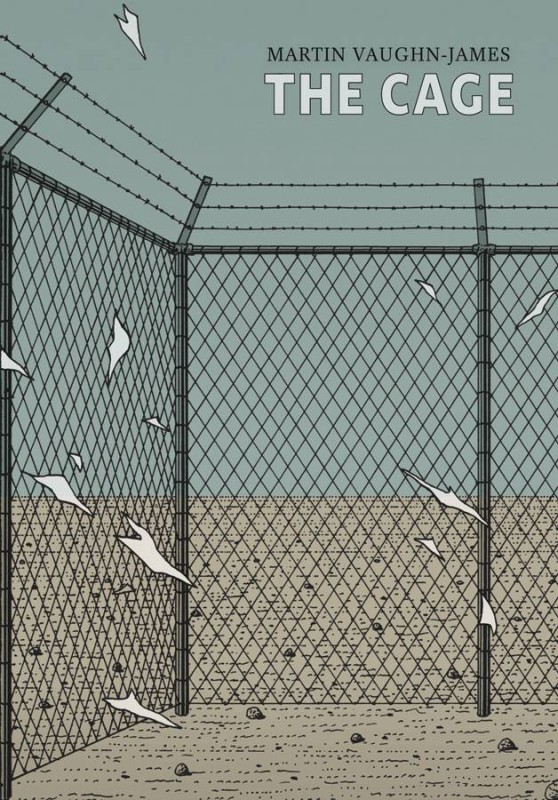Hello!
What follows is an excerpt of Seth’s appreciation of Martin Vaughn-James’ THE CAGE, which appears in Coach House’s new edition being released tonight in Toronto. We hope that you’re already headed down to Revival for the 7:30 start time, but just in case you need a little last minute convincing, I think Seth does a very good job of it.
Our thanks to Coach House for letting us run this excerpt.
Man Fears Time, But Time Fears Only The Pyramids
An appreciation by Seth
I first encountered Martin Vaughn-James’s work sometime back in the late eighties at a (sadly, vanished) independent bookstore, This Ain’t the Rosedale Library. I was a frequent enough patron for co-owner Charlie Huisken to have known I was a cartoonist, because I recall him excitedly cornering me one day to let me know he’d acquired a stack of first-edition hardcovers of The Cage and The Projector. I had no idea what he was talking about, but from his tone of voice I gathered that a cultured person would know about such things and so I played along. I bought both books, though neither of them was particularly to my taste. Back then (and today, still) I tended to favour a fluid line in drawing that is easily recognized as coming from the commercial cartooning of the early twentieth century – the kind of line the cartoonist of the old New Yorker drew with. I am deeply drawn to the simplicity and boldness found in the comics of Hergé or Charles Schulz: a slick, sensual line that has spontaneity and evidence of the human hand in it. The drawings inside Vaughn-James’s books looked rather clinical. Photorealistic even. To me these books had the appearance more of a manual of diagrams than of comics I loved; they were almost the direct opposite of the comics I was drawn to. I doubted these were my cup of tea. Yes, the oddness of the content was intriguing, but truthfully I was more swayed by Charlie’s implication that I would be a fool to pass them up.
You’re likely expecting to read that when I got home and read them, I fell deeply in love with both books, rushing back to thank Charlie for changing my life by exposing me to the light of a lost genius. But that is certainly not the case. I didn’t fall in love with them; in fact, I was totally perplexed by them. I don’t think I initially liked these books at all. I found them cold and impenetrable – maybe even off-putting.
Yet they weren’t so cold, off-putting and impenetrable that I didn’t continue thinking about them. Honestly, I couldn’t make heads nor tails of them and yet I was quite sure that these books were more than just some old ‘hippy psychedelia.’ There was a clear seriousness of purpose about the books that kept me returning to them. And, being the collector type that I am, I even tracked down the rest of Vaughn-James’s work to study. It was all interesting, and as expected, it was all perplexing. He’s not an easy artist to like. He asks an awful lot of the reader. But I stuck with him and in time came to recognize that The Cage was the work I most admired of him – his masterpiece.
I don’t use the word ‘masterpiece’ lightly. I think The Cage is a masterpiece of comic art. Published in 1975, it is a visionary graphic novel, far ahead of its time – so far ahead of its time that it was ages before that awkward term had even come into popular usage. True, an art comic book wasn’t completely unprecedented; The Cage emerges, in some ways, from the underground comics of the late sixties and seventies. But it is so utterly unique that it is barely recognizable as a part of that movement – I certainly never thought of Martin Vaughn-James’s work as having anything to do with Robert Crumb or Gilbert Shelton or the like. The underground connection is definitely there, but probably more as spark of inspiration than a direct influence.
I’m not sure if I considered it a ‘comic book’ when I first read it. It doesn’t have the appearance of a comic. There are no word balloons, no characters, the drawing is diagrammatic rather than expressive – it doesn’t even have more than one panel per page. If it were the only book he’d ever produced I might be more likely to think he’d patterned it on a children’s picture book. It is only when you look at Vaughn-James’s full body of work that it becomes obvious that The Cage is definitely a comic book. His previous ‘graphic novels,’ Elephant (1970) and The Projector (1971), both incorporate all the traditional surface elements that spell ‘comics’: panels, characters, balloons, brushwork, etc. Also clear is that Vaughn-James is refining his approach during this era. The progression from Elephant to The Projector is an obvious one, as is the progression from The Projector to The Cage. Only when you look at the jump from Elephant to The Cage do you see what a real artistic leap that is: Elephant is an interesting early experiment at an artsy comic book novel, and The Cage is a fully realized artistic masterpiece of the comics medium. To be fair, I should mention that there is another book, The Park, between The Projector and The Cage. In every way it is closer to The Cage than his previous books but it is a very short book (just a short story, really) and, in my opinion, is easily viewed as a warmup for his masterpiece.
—
You can read the rest of this appreciation in THE CAGE, available beginning tonight at the launch or thereafter at The Beguiling Books & Art.
– Chris @ The Beguiling

